This is an old revision of this page, as edited by EmausBot (talk | contribs) at 12:55, 18 April 2012 (r2.7.2+) (Robot: Modifying ar:منطقة كتالونيا). The present address (URL) is a permanent link to this revision, which may differ significantly from the current revision.
Revision as of 12:55, 18 April 2012 by EmausBot (talk | contribs) (r2.7.2+) (Robot: Modifying ar:منطقة كتالونيا)(diff) ← Previous revision | Latest revision (diff) | Newer revision → (diff)Error: no context parameter provided. Use {{other uses}} for "other uses" hatnotes. (help).
Autonomous Community in Spain| Catalonia
Error: {{Lang}}: text has italic markup (help) Template:Ca icon Error: {{Lang}}: text has italic markup (help) Template:Es icon Error: {{Lang}}: text has italic markup (help) Template:Oc icon | |
|---|---|
| Autonomous Community | |
 Flag Flag Coat of arms Coat of arms | |
| Anthem: Els Segadors | |
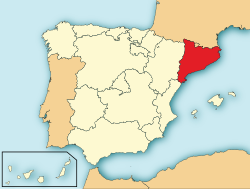 Location of Catalonia Location of Catalonia | |
| Country | Spain |
| Capital | Barcelona |
| Provinces | Barcelona, Girona, Lleida, and Tarragona |
| Government | |
| • Type | Devolved government in a constitutional monarchy |
| • Body | Generalitat de Catalunya |
| • President | Artur Mas (CiU) |
| Area | |
| • Total | 32,114 km (12,399 sq mi) |
| • Rank | 6th (6.3% of Spain) |
| Population | |
| • Total | 7,535,251 |
| • Density | 230/km (610/sq mi) |
| • Pop. rank | 2nd (16% of Spain) |
| Demonym(s) | Catalan català (m), catalana (f) catalán (m), catalana (f) |
| Time zone | UTC+1 (CET) |
| • Summer (DST) | UTC+2 (CEST) |
| ISO 3166-2 | CT |
| Area code | +34 97- (Catalonia) +34 93 (Barcelona) |
| Official languages | Catalan, Spanish and Aranese (Occitan) |
| Statute of Autonomy | 9 August 2006 |
| Patron saint | Saint George (Sant Jordi) |
| Parliament | 135 deputies |
| Congress | 47 deputies (out of 350) |
| Senate | 16 senators (out of 264) |
| Website | Generalitat de Catalunya |
Catalonia (English: /kætəˈloʊniə/, /kætəˈloʊnjə/; Template:Lang-ca Template:IPA-ca or Template:IPA-ca; Template:Lang-es Template:IPA-es; Template:Lang-oc [kataˈluɲɔ]) is a country that is part of Spain as autonomous community in northeastern Iberian Peninsula, with the official status of a "nationality" of Spain. Catalonia comprises four provinces: Barcelona, Girona, Lleida, and Tarragona. Its capital and largest city is Barcelona which is the second Spanish city by population after Madrid. Catalonia covers an area of 32,114 km² and has an official population of 7,535,251. Its borders essentially reflect those of the former Principality of Catalonia. It borders France and Andorra to the north, Aragon to the west, the Valencian Community to the south, and the Mediterranean Sea to the east (580 km coastline). The official languages are Catalan, Spanish and Aranese (Occitan).
Etymology
The name Catalunya (Catalonia) began to be used in the late 11th century in reference to the group of counties that comprised the Marca Hispanica. The origin of the term is subject to diverse interpretations. A theory suggests that Catalunya derives from the term "Land of Castles", having evolved from the term castlà, the ruler of a castle (see castellan). This theory therefore suggests that the name Castile and Catalonia have the same etymology.
Another theory suggests that Catalunya (Latin Gathia Launia) derives from the name Gothia (or Gauthia), "Land of the Goths", since the Spanish March was first known as Gothia, whence Gothland > Gothlandia > Gothalania > Catalonia theoretically derived.
Yet another less accepted theory points to the Lacetani, an Iberian tribe that lived in the area and whose name, due to the Roman influence, could have evolved by metathesis to Katelans and then Catalans.
History
Main article: History of Catalonia


Like some other parts in the rest of the Mediterranean coast of the Iberian Peninsula, Catalonia was colonised by Ancient Greeks, who settled around the Roses area. Both Greeks and Carthaginians (who, in the course of the Second Punic War, briefly ruled the territory) interacted with the main Iberian substratum. After the Carthaginian defeat by Rome, it became, along with the rest of Hispania, part of the Roman Empire, Tarraco being one of the main Roman posts in the Iberian Peninsula.


Catalonia then came under Visigothic rule for four centuries after Rome's collapse. In the 8th century, it came under Moorish Al-Andalus control. Still, after the defeat of Emir Abdul Rahman Al Ghafiqi's troops at Tours in 732, the Franks conquered former Visigoth states which had been captured by the Muslims or had become allied with them in what today is the northernmost part of Catalonia. Charlemagne created in 795 what came to be known as the Marca Hispanica, a buffer zone beyond the province of Septimania made up of locally administered separate petty kingdoms which served as a defensive barrier between the Umayyad Moors of Al-Andalus and the Frankish Kingdom.
The Catalan culture started to develop during the Middle Ages in a number of these petty kingdoms organised as small counties throughout the northernmost part of Catalonia. The counts of Barcelona were Frankish vassals nominated by the emperor and then the king of France, to whom they were feudatories (801–987).
In 987 the count of Barcelona did not recognise the French king Hugh Capet and his new dynasty, which put Catalonia effectively beyond Frankish rule. In 1137, Ramon Berenguer IV, Count of Barcelona married Queen Petronilla of Aragon, establishing the dynastic union of the County of Barcelona with the Kingdom of Aragon that was to create the Crown of Aragon.
It was not until 1258, by means of the Treaty of Corbeil, that the king of France formally relinquished his feudal lordship over the counties of the Principality of Catalonia to the king of Aragon James I, descendant of Ramon Berenguer IV. This Treaty transformed the region's de facto autonomy into a de jure direct Aragonese rule. As part of the Crown of Aragon, Catalonia became a maritime power, helping expand the Crown by trade and conquest into the Kingdom of Valencia, the Balearic Islands, and ultimately even Sardinia, Sicily, Corsica, Naples, Athens.
Aragon had been very severely hit by the Black Death and by continuing outbreaks of plague. According to John Huxtable Elliott, "Between 1347 and 1497 the Principality had lost 37% of its inhabitants, and was reduced to a population of something like 300,000."
In 1410, King Martin I died without surviving descendants. As a result, by the Pact of Caspe, Ferdinand of Antequera from the Castilian dynasty of Trastámara received the Crown of Aragon as Ferdinand I of Aragon.
His grandson, King Ferdinand II of Aragon, and Queen Isabella I of Castile married in 1469, becoming the Catholic Monarchs; subsequently, this event was seen as the dawn of the Kingdom of Spain. At that point, though personally and informally unified, the Crowns of Castile and Aragon maintained distinct territories, each keeping its own traditional institutions, Parliaments, and laws. Castile commissioned the expeditions to the Americas, and benefited from the colonial riches. Political power had shifted away from Aragon toward Castile and, subsequently, from Castile to the Spanish Empire. King Charles V was the first sole monarch holding the crowns of both Aragon and Castile.
For an extended period, Barcelona (not Catalonia), as part of the former Kingdom of Aragon, continued to retain its own usages and laws, but these gradually eroded in the course of the transition from feudalism to a modern state, fueled by the kings' struggle to have more centralized territories. Over the next few centuries, Catalonia was generally on the losing side of a series of local conflicts that led steadily to more centralization of power in Spain, like the Reapers' War (1640–52). In 1659 the Spanish Crown offered the Roussillon territory to the Kingdom of France. Now this territory is the Department of Pyrénées-Orientales, and also is named Northern Catalonia (Catalunya Nord).
The most significant conflict was the War of the Spanish Succession, which began when Charles II of Spain (the last Spanish Habsburg) died without a direct heir in 1700. Catalonia, like the other territories that had formed the Crown of Aragon in the Middle Ages, mostly rose up in support of the Habsburg pretender Charles VI of Valencia Holy Roman Emperor, while the rest of Spain mostly adhered to the French Bourbon claimant, Philip V. Following the fall of Barcelona on 11 September 1714, the "special status" of the territories belonging to the former Crown of Aragon and its institutions was abolished by the Nueva Planta decrees, under which all its lands were incorporated to the Crown of Castile as provinces, within a united Spanish administration, as Spain moved towards a centralised government under the new Bourbon dynasty.
In the latter half of the 19th century, Catalonia became an industrial center; to this day it remains one of the most industrialised parts of Spain. In the first third of the 20th century, Catalonia gained and lost varying degrees of autonomy several times, receiving its first statute of autonomy during the Second Spanish Republic (1931). This period was marked by political unrest and the preeminence of the Anarchists during the Spanish Civil War (1936–39). The Anarchists had been active throughout the early 20th century, achieving the first eight-hour workday in the world in 1919. After the defeat of the Republic in the civil war, which brought General Francisco Franco to power, his regime suppressed any kind of public activities associated with Catalan nationalism, Anarchism, Socialism, Democracy or Communism, including the publication of books on those subjects or simply discussion of them in open meetings. As part of this suppression, the use of Catalan in government-run institutions and during public events was banned. During later stages of the Franco regime, certain folkloric and religious celebrations in Catalan resumed and were tolerated. Use of Catalan in the mass media had been forbidden, but was permitted from the early 1950s in the theatre. Publishing in Catalan continued throughout the dictatorship.
After Franco's death (1975) and with the adoption of a democratic Spanish Constitution (1978), Catalonia recovered political and cultural autonomy. Today, Catalonia is one of the most economically dynamic regions of Spain. The Catalan capital and largest city, Barcelona, is a major international cultural centre and a major tourist destination.
Geography
| This section needs expansion. You can help by adding to it. (April 2012) |
Climate
The climate of Catalonia is diverse. The populated areas lying by the coast in Tarragona, Barcelona and Girona provinces feature a Mediterranean climate (Köppen Csa). The inland part (including the Lleida province and the inner part of Barcelona province) show a mostly continental Mediterranean climate (Köppen Csa). The Pyrenean peaks have a mountain (Köppen H) or even Alpine climate (Köppen ET) at the highest summits, while the valleys have a maritime or oceanic climate sub-type (Köppen Cfb).
In the Mediterranean area, summers are dry and hot with sea breezes, and the maximum temperature is around 26-31 °C. Winter is cool or slightly cold depending on the location. It snows frequently in the Pyrenees, and it occasionally snows at lower altitudes, even by the coastline. Spring and autumn are typically the rainiest seasons, except for the Pyrenean valleys, where summer is typically stormy.
The inland part of Catalonia is hotter and drier in summer. Temperature may reach 35 °C, some days even 40 °C. Nights are cooler there than at the coast, with the temperature of around 14-16 °C. Fog is not uncommon in valleys and plains; it can be especially persistent, with freezing drizzle episodes and subzero temperatures during winter, along the Segre and in other river valleys.
Ecology
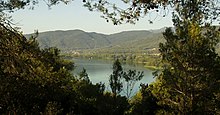
| This section needs expansion. You can help by adding to it. (April 2012) |
Flora and fauna
| This section needs expansion. You can help by adding to it. (April 2012) |
Rivers
| This section needs expansion. You can help by adding to it. (April 2012) |
Regions
| This section needs expansion. You can help by adding to it. (April 2012) |
Politics
Main articles: Politics of Catalonia and Politics of Spain| Politics of Catalonia |
|---|
 |
Statute and lawsStatute of Autonomy
|
| GeneralitatPresident (list) |
ExecutiveExecutive Council
|
| LegislatureParliament (15th) |
JudiciaryHigh Court of Justice
|
Public order
|
| Political partiesParliamentary parties |
|
ElectionsParliamentary elections
Referendums |
|
SubdivisionsRegional
Local |
After Franco's death in 1975 and the adoption of a democratic constitution in Spain in 1978, Catalonia recovered, and extended, the powers that it had gained in the Statute of Autonomy of 1932 but lost with the fall of the Second Spanish Republic at the end of the Spanish Civil War in 1939.
The region has gradually achieved more autonomy since 1979. The Generalitat holds exclusive jurisdiction in culture, environment, communications, transportation, commerce, public safety and local government, and shares jurisdiction with the Spanish government in education, health and justice.
A relatively large sector of the population supports the ideas and policies of Catalan nationalism (also known as Catalanism), a political movement which defends the notion that Catalonia is a separate nation and advocates for either further political autonomy or full independence of Catalonia.
In the last Catalan parliamentary election, the parties that are considered nationalist have obtained 50.02% of the votes and hold 72 of the 135 seats in the Catalan Parliament. Parties supporting full independence from the rest of Spain have obtained 11.56% of the votes, down from 14.08% in 2006 and 16.5% in 2003.
Parties that consider themselves either Catalan nationalist or independentist have been present in all Catalan governments since 1980. The largest Catalan nationalist party, Convergence and Union, has ruled Catalonia from 1980 to 2003, and has come back to power in the 2010 election. Between 2003 and 2010, a leftist coalition, composed by the Catalan Socialists' Party, the pro-independence Republican Left of Catalonia and the leftist-environmentalist Initiative for Catalonia-Greens, implemented policies that widened Catalonian autonomy.
The support for Catalan nationalism ranges from the desire for independence from the rest of Spain, expressed by Catalan independentists, to a more general demand for further autonomy and the federalisation of Spain. Since 2007, support for Catalan independence has been on the rise. According to an opinion poll from July 2007, two thirds of Catalans believed Catalonia should have a higher level of autonomy, but only 16.5% supported full independence from Spain. The first survey following the Constitutional Court ruling that cut back elements of the 2006 Statute of Autonomy, published by La Vanguardia on July 18, 2010, found that a majority would support independence in a referendum. Already in February of the same year, a poll by the Open University of Catalonia gave more or less the same results. Other polls have shown lower support for independence, ranging from 40 to 49%.
In dozens of non-binding local referendums on independence, organised across Catalonia from 13 September 2009, a large majority voted for independence, although critics argued that the polls were mostly held in pro-independence areas. As of December 2009, 94% of those voting backed independence from Spain, on a turn out of 25%. The final local referendum is planned for Barcelona, in April 2011.
Statutes of Autonomy
Main articles: Autonomous Communities of Spain and Statute of Autonomy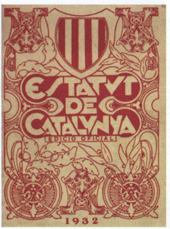
The Statute of Autonomy of Catalonia is the fundamental organic law, second only to the Spanish Constitution from which the Statute originates.
In the Spanish Constitution of 1978 Catalonia, along with the Basque Country and Galicia, was defined as a "nationality". The same constitution gave Catalonia the automatic right to autonomy, which resulted in the Statute of Autonomy of Catalonia of 1979.
Both the 1979 Statute of Autonomy and the current one, approved in 2006, state that "Catalonia, as a nationality, exercises its self-government constituted as an Autonomous Community in accordance with the Constitution and with the Statute of Autonomy of Catalonia, which is its basic institutional law, always under the law in Spain".
The Preamble of the 2006 Statute of Autonomy of Catalonia states that the Parliament of Catalonia has defined Catalonia as a nation, but that "the Spanish Constitution recognizes Catalonia's national reality as a nationality". While the Statute was approved by and sanctioned by both the Catalan and Spanish parliaments, and later by referendum in Catalonia, it has been subject to a legal challenge by the surrounding autonomous regions of Aragon, Balearic Islands and the Valencian Community, as well as by the conservative People's Party. The objections are based on various issues such as disputed cultural heritage but, especially, on the Statute's alleged breaches of the principle of "solidarity between regions" in fiscal and educational matters enshrined by the Constitution. After considerable legal debate, Spain's Constitutional Court assessed the disputed articles and on 28 June 2010, issued its judgment on the principal allegation of unconstitutionality presented by the People's Party in 2006. The judgment granted clear passage to 182 articles of the 223 that make up the fundamental text. The court approved 73 of the 114 articles that the People's Party had contested, while declaring 14 articles unconstitutional in whole or in part and imposing a restrictive interpretation on 27 others. The court accepted the specific provision that described Catalonia as a "nation", however ruled that it was a historical and cultural term with no legal weight, and that Spain remained the only nation recognized by the constitution.
Government and law
Main article: Generalitat de Catalunya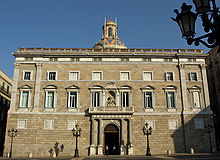
The Catalan Statute of Autonomy establishes that Catalonia is organised politically through the Generalitat de Catalunya, conformed by the Parliament, the Presidency of the Generalitat, the Government or Executive Council and the other institutions created by the Parliament.
The seat of the Executive Council is the city of Barcelona. Since the restoration of the Generalitat on the return of democracy in Spain, the presidents of Catalonia have been Jordi Pujol (1980–2003), Pasqual Maragall (2003–2006), José Montilla Aguilera (2006–2010) and Artur Mas incumbent as of 2010.
Security forces
Main article: Mossos d'EsquadraCatalonia has its own police force, the Mossos d'Esquadra, whose origins date back to the 18th century. Since 1980 they have been under the command of the Generalitat, and since 1994 they have expanded in number in order to replace the national Guardia Civil and Policía Nacional, which report directly to the Homeland Department of Spain. The national bodies retain personnel within Catalonia to exercise functions of national scope such as overseeing ports, airports, coasts, international borders, custom offices, the identification of documents and arms control amongst others.
Most of the justice system is administered by national judicial institutions. The criminal justice system is uniform throughout Spain, while "civil law" is administered separately within Catalonia.
Navarre, the Basque Country and Catalonia are the Spanish regions with the highest degree of autonomy in terms of law enforcement.
Administrative and territorial division

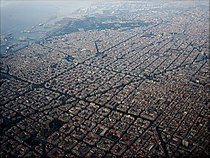
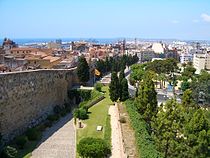


Catalonia is organised territorially into provinces, further subdivided into comarques and municipalities. The 2006 Statute of Autonomy of Catalonia establishes the administrative organization of three local authorities: vegueries, comarques, and municipalities.
Provinces
Further information: Provinces of SpainCatalonia is divided administratively into four provinces, the governing body of which is the Diputació (Template:Lang-es). The four provinces and its population are:
- Province of Barcelona: 5,507,813 population.
- Province of Girona: 752,026 population.
- Province of Lleida: 439,253 population.
- Province of Tarragona: 805,789 population.
Municipalities
Further information: Municipalities of CataloniaThere are at present 947 municipalities in Catalonia.
| Ranking | Municipality | Comarca | Population |
|---|---|---|---|
| 1 | Barcelonès | 1,621,537 | |
| 2 | Barcelonès | 257,038 | |
| 3 | Barcelonès | 219,547 | |
| 4 | Vallès Occidental | 210,941 | |
| 5 | Vallès Occidental | 206,493 | |
| 6 | Tarragonès | 164,323 | |
| 7 | Segrià | 160,919 | |
| 8 | Maresme | 121,722 | |
| 9 | Barcelonès | 119,717 | |
| 10 | Baix Camp | 107,118 |
Comarques
Main article: Comarques of CataloniaComarques are entities composed by the municipalities to manage their responsibilities and services. The current regional division has its roots in a decree of the Generalitat de Catalunya of 1936 in effect until 1939 when it suppressed by Franco. In 1987 the Government adopted the territorial division again in 1988 and three new comarques were added (Alta Ribagorça, Pla d'Urgell i Pla de l'Estany). At present there are 41.
The comarca of Val d'Aran (Aran Valley) has a special status and its autonomous government is named Conselh Generau d'Aran.
Vegueries
Main article: Vegueries of CataloniaVegueria is a new division defined as a specific territorial area for the exercise of government and inter-local cooperation with legal personality. The current Statute of Autonomy states vegueries are intended to supersede provinces in Catalonia, and take over many of functions of the comarques.
The territorial plan of Catalonia (Pla territorial general de Catalunya) provided six general functional areas, but was amended by Law 24/2001, of December 31, recognizing the Alt Pirineu i Aran as a new functional area differentiated of Ponent. On 14 July 2010 the Catalan Parliament approved the creation of the functional area of the Penedès.
- Alt Pirineu i Aran: Alta Ribagorça, Alt Urgell, Cerdanya, Pallars Jussà, Pallars Sobirà and Val d'Aran.
- Àmbit Metropolità de Barcelona: Baix Llobregat, Barcelonès, Garraf, Maresme, Vallès Oriental and Vallès Occidental.
- Camp de Tarragona: Tarragonès, Alt Camp, Baix Camp, Conca de Barberà and Priorat.
- Comarques gironines: Alt Empordà, Baix Empordà, Garrotxa, Gironès, Pla de l'Estany, La Selva and Ripollès.
- Comarques centrals: Anoia (7 municipalities of 33), Bages, Berguedà, Osona and Solsonès.
- Penedès: Alt Penedès, Baix Penedès, Anoia (26 municipalities of 33) and Garraf.
- Ponent: Garrigues, Noguera, Segarra, Segrià, Pla d'Urgell and Urgell.
- Terres de l'Ebre: Baix Ebre, Montsià, Ribera d'Ebre and Terra Alta.
Economy
Main article: Economy of Spain
In 2008 the regional GDP of Catalonia was €216.9 billion ($314.4 billion), the highest in Spain, and per capita GDP was €30,700 – similar to that of countries such as the United Kingdom or Austria. However, it had the fourth per capita GDP in Spain, considerably behind the Basque Country (€34,100), Madrid (autonomous community) (€34,100) and Navarra (€32,900). In that year, the GDP growth was 3.7%. In the context of the 2008 financial crisis, Catalonia is expected to suffer a recession amounting to almost a 2% contraction of its regional GDP in 2009.
In 2011, Catalonia ranked the 50th largest country subdivision by GDP (nominal), just behind Queensland (Australia) and ahead Rio de Janeiro state (Brazil). Catalonia is one of the Four Motors for Europe.
The distribution of sectors is as follows:
- Primary sector: 2.8%. The amount of land devoted to agricultural use is 33%.
- Secondary sector: 37.2% (compared to Spain's 29%)
- Tertiary sector: 60% (compared to Spain's 67%)
The main tourist destinations in Catalonia are the city of Barcelona, the beaches of the Costa Brava in Girona, the beaches of Costa Bercelona from Mataró to Vilanova i la Geltrú and the Costa Daurada in Tarragona. In the Pyrenees there are several ski resorts, near Lleida
Many savings banks are based in Catalonia, with 10 of the 46 Spanish savings banks having headquarters in the region. This list includes Europe's premier savings bank, La Caixa. The first private bank in Catalonia is Banc Sabadell, ranked fourth among all Spanish private banks.
The stock market of Barcelona, which in 2004 traded almost €205,000 million, is the second largest of Spain after Madrid, and Fira de Barcelona organizes international exhibitions and congresses to do with different sectors of the economy.
The main economic cost for the Catalan families is the purchase of a home. According to data from the Society of Appraisal on the 31 December 2005 Catalonia is, after Madrid, the second most expensive region in Spain for housing: 3,397 €/m² on average (see Spanish property bubble).
Demographics
Main article: Catalan peopleCatalonia covers an area of 32,114 km² with an official population of 7,354,411 (2008) from which non Spanish immigrants represent an estimated 12.3%.
The Urban Region of Barcelona includes 5,217,864 people and covers an area of 2.268 km² and about 1.7 million people live in a radius of 15 km from Barcelona. The metropolitan area of the Urban Region includes cities like L'Hospitalet de Llobregat, Badalona, Santa Coloma de Gramenet and Cornellà de Llobregat.
In 1900 the population of Catalonia was 1,984,115 people and in 1970 it was 5,107,606. That increase was produced due to the demographic boom produced in Spain during the 60s and early 70s and also due to the large-scale internal migration produced from the rural interior of Spain to its industrial cities. In Catalonia that wave of internal migration arrived from several regions of Spain, especially Andalusia, Murcia and Extremadura.
Immigration from other countries settled down in Catalonia in the 1990s and 2000s, a large percentage came from Africa and Latin America, and smaller numbers from Asia and Eastern Europe, often settle in urban centers such as Barcelona and industrial areas.
Languages
Main article: Languages of Catalonia See also: Catalan language, Spanish language, and Occitan language
According to the most recent linguistic census held by the Government of Catalonia as of 2009, a plurality claims Spanish as "their own language" (46.53% Spanish compared to 37.26% Catalan). In everyday use, 11.95% of the population claim to use both languages equally, while 45.92% use mainly Spanish and 35.54% use mainly Catalan. There is a significant difference between the Barcelona metropolitan area (and, to a lesser extent, the Tarragona area), where Spanish is more spoken than Catalan, and the rest of Catalonia, where Catalan clearly prevails over Spanish.
Also, starting with the Statute of Autonomy of 1979, Aranese (a dialect of Gascon Occitan) has been official and subject to special protection in Val d'Aran. This small area of 7,000 inhabitants was the only place where a dialect of Occitan has received full official status. Then, on 9 August 2006, when the new Statute came into force, Occitan became official throughout Catalonia. Occitan is the mother tongue of 22.4% of the population of Val d'Aran.
Originating in the historic territory of Catalonia, Catalan has enjoyed special status since the approval of the Statute of Autonomy of 1979 which declares it to be the "own language of Catalonia", a term which signifies a language given special legal status within a Spanish territory, or which is historically spoken within a given region. The other languages with official status are Spanish, which has official status throughout Spain, and Aranese Occitan, which enjoys co-official status with Catalan and Spanish in the Val d'Aran.
Under the Franco dictatorship, Catalan was excluded from the public education system and all other official use, so that for example families were not allowed to officially register children with Catalan names. While never completely banned, Catalan language publishing was severely restricted during the early '40s, with only religious texts and small-run self-published texts being released. Some books were published clandestinely or circumvented the restrictions by showing publishing dates prior to 1936. This policy was changed in 1946, when unrestricted publishing in Catalan resumed. Rural-urban migration originating in other parts of Spain also reduced the social use of the language in urban areas, while increasing the use of Spanish. Lately, a similar sociolinguistic phenomenon has occurred with foreign immigration. Catalan cultural activity increased in the 1960s and Catalan classes began thanks to the initiative of associations such as Òmnium Cultural.
After the end of Franco's dictatorship, the newly established self-governing democratic institutions in Catalonia embarked on a long-term language policy to increase the use of Catalan and has, since 1983, enforced laws which attempt to protect and extend, the use of Catalan. This policy, known as the "linguistic normalization" (normalització lingüística in Catalan, normalización lingüística in Spanish) has been supported by the vast majority of Catalan political parties through the last thirty years. Some groups consider these efforts a way to discourage the use of Spanish, while some others, including the Catalan government and the European Union consider the policies respectful, or even as an example which "should be disseminated throughout the Union". Recently, some of these policies have been criticized for trying to promote Catalan by imposing fines on businesses. For example, following the passage of a March 2010 law on Catalan cinema, which establishes that half of the movies shown in Catalan cinemas must be in Catalan, a general strike of 75% of the cinemas took place. These criticisms mostly come from outside Catalonia, especially from conservative, conservative liberal and classical liberal circles of Spanish society. In Catalonia, on the other hand, there is a high social and political consensus on the language policies favoring Catalan, also among Spanish speakers and speakers of other languages. In Catalonia, the Catalan language policy has been challenged by some anti-nationalist intellectuals like Albert Boadella. Since 2006, the liberal Citizens - Party of the Citizenry has been one of the most consistent critics of the Catalan language policy within Catalonia. The local Catalan branch of the People's Party has a more ambiguous position on the issue: on one hand, it demands a bilingual Catalan-Spanish education and a more balanced language policy that would defend Catalan without favoring it over Spanish, while on the other, a few local PP politicians have supported in their municipalities measures privileging Catalan over Spanish and it has defended some aspects of the official language policies, sometimes against the positions of its colleagues from other parts of Spain.
Today, Catalan is the main language of the Catalan autonomous government and the other public institutions that fall under its jurisdiction. Basic public education is given in Catalan, except for two hours per week of Spanish medium instruction. Businesses are required to display all information (e.g. menus, posters) in Catalan under penalty of fines. There is no obligation to display this information in either Occitan or Spanish, although there is no restriction on doing so in these or other languages. The use of fines was introduced in a 1997 linguistic law that aims to increase the public use of Catalan and defend the rights of Catalan speakers. The law ensures that both Catalan and Spanish – being official languages – can be used by the citizens without prejudice in all public and private activities, but primary education can only be taken in Catalan language. The Generalitat uses Catalan in its communications and notifications addressed to the general population, but citizens can also receive information from the Generalitat in Spanish if they so desire. debates in the Catalan Parliament take place almost exclusively in Catalan and the Catalan public television broadcasts programs only in Catalan.
Due to the intense immigration which Spain in general and Catalonia in particular experienced in the first decade of the 21st century, many foreign languages are spoken in various cultural communities in Catalonia, of which Riff Berber, Moroccan Arabic, Romanian and Urdu are the more common.
Transport
Airports
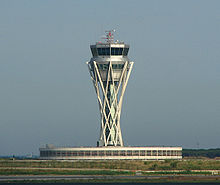
Airports in Catalonia are owned and operated by Aena (a Spanish Government entity) except two airports in Lleida which are operated by Aeroports de Catalunya (an entity belonging to the Government of Catalonia).
- Barcelona International Airport (BCN, Aena)
- Girona-Costa Brava Airport (GRO, Aena)
- Reus Airport (REU, Aena)
- Lleida-Alguaire Airport (ILD, Aeroports de Catalunya)
- Sabadell Airport (QSA, Aena)
- La Seu d'Urgell Airport (LEU, Aeroports de Catalunya)
Commercial and passenger ports
The two main commercial and passenger ports in Catalonia are owned and operated by Puertos del Estado (a Spanish Government entity).
- Port of Barcelona
- Port of Tarragona
Roads
See also: List of autopistes and autovies in Catalonia
There are 12,000 km of roads throughout Catalonia.
The principal highways are AP-7 (Autopista del Mediterrani) and A-7 (Autovia del Mediterrani). It follows the coast from the French border to Valencia, Murcia and Andalusia. The main roads generally radiate from Barcelona. The A-2 and AP-2 connect inland and onward to Madrid.
Other major roads are:
Public-own roads in Catalonia are either managed by the autonomous government of Catalonia (e.g. C- roads) or the Spanish Government (e.g. AP- , A- , N- roads).
Railways

Catalonia saw the first railway construction in the Iberian Peninsula in 1848, linking Barcelona with Mataró. Given the topography most lines radiate from Barcelona. The city has both suburban and inter-city services. The main east coast line runs through the province connecting with the SNCF (French Railways) at Portbou on the coast.
There are two publicly owned railway companies operating in Catalonia: the Catalan FGC that operatates commuter and regional services, and the Spanish national RENFE that operates long-distance and high speed rail services (AVE and Avant).
High speed rail (AVE) services from Madrid currently reach Lleida, Tarragona and Barcelona. The official opening between Barcelona and Madrid took place 20 February 2008. The journey between Barcelona and Madrid now takes about 2 and a half hours. Construction has commenced to extend the high speed line northwards to connect with the French high speed TGV network. This new line passes through Girona and there will be a tunnel through the Pyrenees.
Location
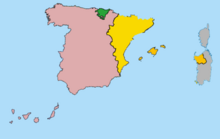
Culture
Symbols of Catalonia
Main article: Catalan symbolsCatalonia has its own representative and distinctive symbols such as:

- The flag of Catalonia, called La Senyera, is a vexillological symbol based on the heraldic emblem of Counts of Barcelona and the coat of arms of the Crown of Aragon, which consists of four red stripes on a golden background. It is an official symbol since the Statute of Catalonia of 1932.
- The National Day of Catalonia is on the Eleventh of September, and it is commonly called La Diada. It commemorates the 1714 Siege of Barcelona defeat during the War of the Spanish Succession.
- The anthem of Catalonia is Els Segadors and was written in its present form by Emili Guanyavents in 1899. The song is official by law from 25 February 1993. It is based on the events of 1639 and 1640 during the Catalan Revolt.
- St George's Day (Template:Lang-ca) is widely celebrated in all the towns of Catalonia on 23 April, and includes an exchange of books and roses.
UNESCO World Heritage Sites in Catalonia
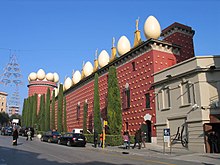
There are several UNESCO World Heritage Sites in Catalonia:
- Archaeological Ensemble of Tarraco, Tarragona
- Catalan Romanesque Churches of the Vall de Boí, Lleida province
- Poblet Monastery, Poblet, Tarragona province
- Palau de la Música Catalana and Hospital de Sant Pau, Barcelona
- Works of Antoni Gaudí:
- Sagrada Família, Barcelona
- Parc Güell, Barcelona
- Palau Güell, Barcelona
- Casa Milà (La Pedrera), Barcelona
Popular culture

Castells are one of the main manifestations of Catalan popular culture. The activity consists in constructing human towers by competing colles castelleres (teams). This practice originated in the southern part of Catalonia during the 18th century.
The sardana is the most characteristic Catalan popular dance, other groups also practice Ball de bastons, moixiganga, galops or jota in the southern part. Musically, the Havaneres are also characteristic in some marine localities of the Costa Brava especially during the summer months when these songs are sung outdoors accompanied by a cremat of burned rum. Other music styles are Catalan rumba, Catalan rock and Nova Cançó.
In the greater celebrations other elements of the Catalan popular culture are usually present: the parades of gegants (giants) and correfocs of devils and firecrackers. Another traditional celebration in Catalonia is La Patum de Berga declared Masterpiece of the Oral and Intangible Heritage of Humanity by UNESCO in 25 November 2005.
In addition to traditional local Catalan culture, traditions from other parts of Spain can be found as a result of migration from other regions. On July 28, 2010, Catalonia became the second Spanish territory, after the Canary Islands, to forbid bullfighting. The ban, which will be effective as of January 1, 2012, had originated in a popular petition supported by over 180,000 signatures.
Image gallery
- Catalonia gallery
-
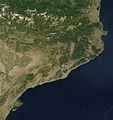 Satellite view of Catalonia
Satellite view of Catalonia
-
 Llívia exclave
Llívia exclave
-
 Val de Ruda, Val d'Aran
Val de Ruda, Val d'Aran
-
Tossa de Mar
-
 Aigua Blava
Aigua Blava
-
Cruïlles, Monells i Sant Sadurní de l'Heura
-
 Tortosa
Tortosa
-
 Museu Nacional d'Art de Catalunya, Barcelona
Museu Nacional d'Art de Catalunya, Barcelona
-
 Park Güell, Barcelona
Park Güell, Barcelona
-
 Cathedral of Saint Eulàlia, Barcelona
Cathedral of Saint Eulàlia, Barcelona
See also
Main article: Outline of Catalonia- .cat
- Caga Tió
- Catalan cuisine
- Catalan wine
- Famous Catalan People
- History of Catalonia
- List of rivers of Catalonia
- Music of Catalonia
- National Day of Catalonia
- Northern Catalonia
- Països Catalans
- Principality of Catalonia
- Sport in Catalonia
- Symbols of Catalonia
- Traditions of Catalonia
References
- First article of the Statute of Autonomy of Catalonia. "Catalonia, as a nationality, exercises its self-government constituted as an autonomous community..."
- Idescat.net. Template:Ca icon
- Statute of Autonomy of Catalonia (2006), Article 6. parlament-cat.net.
- Enciclopèdia Catalana online: Catalunya ("Geral de Cataluign, Raimundi Catalan and Arnal Catalan appear in 1107/1112"). Template:Ca icon
- "La formació de Catalunya". Gencat.cat. Retrieved 2010-04-25.
- ^ Historia del nacionalismo catalán - Google Books. Books.google.com. 2006-07-07. Retrieved 2010-04-25.
- Bulke, Ulrich. (1900). A History of Spain from the Earliest Times to the Death of Ferdinand the Catholic. Longman, Greens and Co. London, UK.
- El Misteri de la Paraula Cathalunya.
- La Catalogne : son nom et ses limites historiques. Histoire de Roussillon.
- John Huxtable Elliott (1984). The revolt of the Catalans: a study in the decline of Spain (1598-1640). Cambridge University Press. p. 26. ISBN 0521278902.
- Marc Howard Ross (2007), Cultural Contestation in Ethnic Conflict, Cambridge University Press, p. 139
- Thomas, Earl W (1962), Hispania, vol. 45, pp. 43–8, doi:10.2307/337523
{{citation}}: Unknown parameter|month=ignored (help) - "Beginnings of the autonomous regime, 1918-1932". Gencat.net. Retrieved 2010-04-25.
- "The republican Government of Catalonia, 1931-1939". Gencat.net. Retrieved 2010-04-25.
- "Title IV. Powers (articles 110-173)of the 2006 Statute". Gencat.cat. Retrieved 2010-04-25.
- ^ "CIS Poll covering, among others, nationalist opinions". Cis.es. Retrieved 2010-04-25.
- Books.google.si.
- Video.google.com.
- "La Vanguardia poll".
- UOC.edu.
- Cadenaser.com.
- Racalacarta.com.
- Lavanguardia.es.
- "Spain's Catalonia region in symbolic independence vote". BBC News. 2009-12-14. Retrieved 2010-04-25.
- "First article of the Statute of Autonomy of Catalunya". Gencat.net. Retrieved 2010-04-25.
- Constitución Española, Título Preliminar.
- Europa Press/Madrid (1997-12-01). "Admitidos los recursos de Aragón, Valencia y Baleares contra el Estatuto catalán". Hoy.es. Retrieved 2010-04-25.
- El País (2010-06-29). "Cuatro años de encarnizada batalla política". El País. Retrieved 2010-06-29.
- "Ni un retoque en 74 artículos recurridos". El País. Retrieved 2010-06-29.
- "Catalonia 'is not a nation' 10 July 2010". Edinburgh: News.scotsman.com. 2010-07-10. Retrieved 2011-01-06.
- "Is Catalonia a nation or a nationality, or is Spain the only nation in Spain?". Matthewbennett.es. Retrieved 2011-01-06.
- Fiona Govan in Madrid 1:59PM BST 29 Jun 2010 (2010-06-29). "Catalonia can call itself a 'nation', rules Spain's top court 29 Jun 2010". London: Telegraph.co.uk. Retrieved 2011-01-06.
{{cite news}}: CS1 maint: numeric names: authors list (link) - "A nationality, not a nation Jul 1st 2010". Economist.com. Retrieved 2011-01-06.
- "Legislació civil catalana". Civil.udg.es. 2006-07-20. Retrieved 2010-04-25.
- "Padró municipal d'habitants. Xifres Oficials. Recomptes. Any 2010". idescat. Retrieved 20 July 2010.
- "Actualització INE 2009". Ine.es. 2010-05-28. Retrieved 2011-01-06.
- "Ley 16/1990, de 13 de julio, sobre el régimen especial del Valle de Arán". Noticias Jurídicas. Retrieved 20 July 2010.
- "Pla territorial general de Catalunya". Generalitat de Catalunya. Retrieved 20 July 2010.
- Aprovació del Pla territorial parcial de l'Alt Pirineu i Aran.
- "El Parlament reconeix l'àmbit funcional del Penedès". Avui. 15 de juliol del 2010.
{{cite web}}: Check date values in:|date=(help) - Cidem.com.
- Madrid, con una renta de 28.850 euros por habitante, se sitúa más de un 30 por ciento por encima de la media nacional Madrid tiene el PIB per cápita más alto de España.
- Idescat.cat.
- "BBVA no descarta que la economía catalana caiga un 2% • ELPAÍS.com". Elpais.com. Retrieved 2010-04-25.
- "Structural Funds programmes in Catalonia - (2000-2006)" (PDF). Retrieved 2010-04-25.
- "Ranking of Savings Banks" (PDF). Retrieved 2010-04-25.
- "Profile of "Banc Sabadell" in Euroinvestor". Euroinvestor.es. Retrieved 2011-01-06.
- "Catalunya arriba a set milions d'habitants", Diari El Punt.
- "Catalans grapple with migrant influx", BBC News. 3 January 2007.
- Gencat.net. Template:Ca icon
- "Idescat. Dades demogràfiques i de qualitat de vida". Idescat.cat. Retrieved 2010-04-25.
- Enquesta d'usos lingüístics de la població 2008, cap. 8. La Val d’Aran.
- "Statute of Autonomy of Catalonia (Article 6)". Gencat.cat. Retrieved 2010-04-25.
- Joan Miralles i Monserrat, Josep Massot i Muntaner (2001), "Entorn de la història de la llengua" (Environment of History of Language), Ed. by Publicacions de l'Abadia de Montserrat, ISBN 84-8415-309-6, p. 72.
- Pelai Pagès i Blanch. Franquisme i repressió: la repressió franquista als països catalans 1939-1975. Retrieved 2011-01-06.
- Pelai Pagès i Blanch. Franquisme i repressió: la repressió franquista als països catalans (1939-1975).
- Multilingualism in Spain: Sociolinguistic and Psycholinguistic Aspects of Linguistic Minority Groups. Books.google.com. Retrieved 2010-04-25.
- Belen Parra (2008-06-05). "Diario El Mundo, Spanish Only". Medios.mugak.eu. Retrieved 2010-04-25.
- "Diario El Imparcial, Spanish Only". Elimparcial.es. 2008-07-26. Retrieved 2010-04-25.
- "Diario Periodista Digital, Spanish Only". Blogs.periodistadigital.com. Retrieved 2010-04-25.
- "Diario Periodista Digital, Spanish Only". Blogs.periodistadigital.com. Retrieved 2010-04-25.
- Page 13: Catalan Deputy of Education Ernest Maragall declares respect from the Catalan Government to Spanish language and to everyone's rights. Template:Ca icon
- EU takes Basque Country, Galicia, Catalonia and Valencia as examples of bilingualism.
- The President Montilla promises to look after the use and respect both for Spanish and Catalan languages.
- "High Level Group on Multilingualism - Final Report: from the Commission of the European Communities in which Catalan immersion is taken as an example which "should be disseminated throughout the Union" (page 18)" (PDF). Retrieved 2010-04-25.
- by Louis @ (2010-03-25). "Cinema law: rude case to not dub and subtitle all films in Catalan". Cafebabel.co.uk. Retrieved 2010-04-25.
- ^ Presencia.cat.
- Asabadell.cat.
- Normalitzacio.cat.
- Books.google.si.
- Youtube.com.
- Regio7.cat.
- 3cat24.cat.
- "Catalonia's linguistic law". 0.gencat.cat. Retrieved 2010-04-25.
- "Second article of Catalonia's linguistic law". 0.gencat.cat. Retrieved 2010-04-25.
- "Ninth article of Catalonia's Linguistic Law". 0.gencat.cat. Retrieved 2010-04-25.
- "Ràdio Catalunya - El 80% dels Marroquins que viuen a Catalunya s són Berbers i parlen amazic". Radiocatalunya.ca. 2001-03-19. Retrieved 2010-04-25.
- "Árabe y urdu aparecen entre las lenguas habituales de Catalunya, creando peligro de guetos". Europapress.es. 2009-06-29. Retrieved 2010-04-25.
- "Statute of Catalonia (Article 8)". Gencat.net. Retrieved 2010-04-25.
- "Law 1/1980 where the Parlamient of Catalonia declares that 11th of September is the National Day of Catalonia". Noticias.juridicas.com. Retrieved 2010-04-25.
- "Law 1/1993 National Anthem of Catalonia". Noticias.juridicas.com. Retrieved 2010-04-25.
- Law 1/1993 in the BOE.
- Patum de Berga.
- The Press Association: Catalonia votes to ban bullfighting, 28 July 2010.
![]() This article incorporates text from a publication now in the public domain: Chisholm, Hugh, ed. (1911). Encyclopædia Britannica (11th ed.). Cambridge University Press.
This article incorporates text from a publication now in the public domain: Chisholm, Hugh, ed. (1911). Encyclopædia Britannica (11th ed.). Cambridge University Press. {{cite encyclopedia}}: Missing or empty |title= (help)
External links
- The Generalitat de Catalunya (Government of Catalonia)
- Statute of autonomy of Catalonia
- Xanascat National Network of Youth Hostels of Catalonia
- Statistical information from Idescat (Catalan Institute of Statistics)
- Institut d'Estudis Catalans (Institute of Catalan Studies)
- Lletra. Catalan Literature Online
- Lletra. espai virtual de literatura catalana
- Catalan Hyperencyclopaedia: Encyclopedia with information about Catalonia. Template:En icon
- Catalonia Spain: A Catalonia Weblog.
- A guide to the natural history of Catalonia
- The Spirit of Catalonia. Digital edition of the 1946 book by Oxford Professor Dr. Josep Trueta. Template:En icon
- Fundació d'Estudis Històrics de Catalunya
- Catalan rumba - Rumba catalana - Music from Catalonia
- Fundació Institut Nova Història de Catalunya
- Guide to the Pyrenees mountains of Catalonia
- Museums, archaeological remains and other places related to science to visit in Catalonia
| Comarques of Catalonia | |||||
|---|---|---|---|---|---|
| Official comarques on the Spanish side |
| ||||
| Historical comarques on the French side (Northern Catalonia) |
| ||||
Template:Catalan/Valencian-speaking territories
| Autonomous communities of Spain | ||
|---|---|---|
| Autonomous communities | ||
| Autonomous cities | ||
| Plazas de soberanía | ||